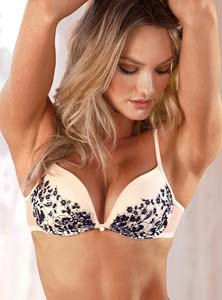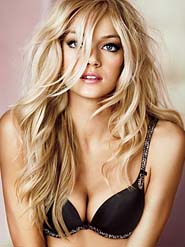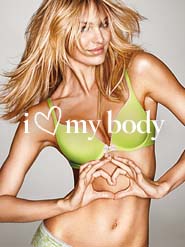Psychoanalysis
A psychoanalytic approach to
observing Victoria's Secret's advertisements has the potential to be the
most helpful in understanding the messages that they send to the general
public. Gillian Rose defines psychoanalysis as "a range of theories that
deal most centrally with human subjectivity, sexuality, and the
unconscious" (Rose 107). In this particular type of analysis, various
theories pertaining to the male gaze and phallocentrism become of utmost
importance. By looking into the details of particular images featured in
Victoria's Secret advertisements, a viewer can identify why certain
sexual attitudes are taken on by the models and by the audiences.
Historically speaking, "the social construction of norms about female
and male sexuality is nowhere seen more clearly than in this sexual
double standard, which allowed and even encouraged premarital sex for
men, but not for women" (Etaugh 168). With this hegemony set in place,
Victoria's Secret participates in the act of releasing a female's sexual
liberties, allowing freedom for women to be overtly sexual. However,
Freud's castration complex also comes into play when observing
Victoria's Secret because it is possible that these models are
representations of women who are lacking a phallus and, therefore, feel
as though they must make up for it with their physicality. By putting
their bodies on display, the models are meant to create a sense of
longing, of desire, in its audience, whether that be in the form of a
female identification or a male objectification. As a result, Victoria's
Secret advertisements become prime examples of the use of the male gaze
to instill a sense of voyeurism in an audience, objectifying the female
models and insinuating that their body types are the ideal for women.
 |
In this first image,
the model is practically baring all. Her purpose is to advertise a
certain pair of underwear, so, naturally, that is all she is
wearing. However, the eyes are not easily drawn to the underwear
because of the direct eye contact she is making with the viewer. By
doing so, she is interpellating the viewer and allowing the audience
to see her as desirable by grabbing the attention herself rather
than letting the underwear, the product being advertised, catch the
eye. To intensify the effect of her eye contact, the model is
positioned in line with the camera, not featured from above or
below. Therefore, the viewer is able to assume that by buying the
underwear that the model is supposed to be advertising, the viewer
can attain that same level of beauty. |
In addition to the model's
ability to make the viewer believe in the possibility of identification
with her, her body is positioned in a sexual manner. With her arms
covering her breasts in order to leave some to the imagination and
create fantasy inside the audience's mind, she is simultaneously
pressing them together to accentuate her feminine features. By placing
her body in display as such, she can be interpreted as taking hold of
her sexuality and using it as power, or she can be interpreted as an
object of male sexual desire. According to Jennie Nash, "you can't
ignore the images of beautiful breasts that pervade our society," and as
a result, people fantasize about as well as idolize those who have them
(Nash 83).
Another important feature of this particular advertisement is
the fact that the underwear is lace because this material plays into the
idea of voyeurism and desire. Berkley Kaite explains that "lace is a
double play: it partially covers areas of the body while permitting
partial access to the same areas" (Kaite 122). In fact, most of the
lingerie featured in Victoria's Secret advertisements are made of lace,
implying that her sexuality is accessible, but still leaves an air of
mystery. This use of lace can also be interpreted as Victoria's Secret's
attempt to lure the audience in, but cut them off before they are able
to see the model's lack of a phallus. Since this could potentially be
construed as destabilizing the feminine power that she is trying to
embody. This advertisement's sexuality in conjunction with its desire to
attract an average audience makes Victoria's Secret an example of how
"bringing together the pornographic with the every day in a format
geared toward female pleasure and autonomy suggests and certain
potential for deconstructing the private-public division that has worked
to contain female sexuality within a traditional definition of home"
(Juffer 31).
| This image is another
example of a Victoria's Secret advertisement, and while the setup is
seemingly different, it portrays very similar messages as the
previous image. This model is serving the purpose of advertising a
particular bra, but despite the ornate detailing on the piece of
lingerie, one's eye cannot help but be drawn to her cleavage. With
her arms reached into the air, she is causing the audience's eye to
trace them downward to the very middle part of the photo,
exemplifying a certain standard for women in lingerie. In opposition
to the first advertisement, this model is not making direct, intense
eye contact with the viewer. In fact, one cannot see her eyes at
all. With this offset gaze, the audience is denied access to the
model's beauty, and as a result, desires her more. Since she is
portraying herself and her standard of beauty as unattainable, it
increases the viewer's sense scophophilia in their subconscious.
|
 |
In both of the aforementioned
Victoria's Secret advertisements, the use of the male gaze is extremely
prevalent. With the models' hair and make up done in an obviously
feminine way, Victoria's Secret is playing into the ideals associated
with women in American society. By emphasizing this archetypical
structure of femininity, Victoria's Secret's advertising is not only
reinforcing societal standards of beauty but also creating standards of
its own, further discussed in the section on discourse analysis.
Works Cited
Etaugh, Claire and Judith S. Bridges. The Psychology of Women: A Lifespan
Perspective. 2nd ed. Boston: Pearson Education, 2004. Print.
Juffer, Jane. "A Pornographic Femininity? Telling and Selling Victoria's (Dirty)
Secrets." Social Text 48 (1996): 27-48. JSTOR. Web. 18 Apr. 2011.
Kaite, Berkeley. Pornography and Difference. Bloomington: Indiana UP, 1995. Print.
Nash, Jennie. The Victoria's Secret Catalog Never Stops Coming: And Other Lessons I
Learned from Breast Cancer. New York: Scribner, 2001. Print.
Rose, Gillian. "Visual Methodologies: An Introduction to the Interpretation of Visual Materials". 2nd ed. London: SAGE, 2007.
Illustrations
All figures: http://www.victoriassecret.com/
Elizabeth Wong
May 2, 2011






